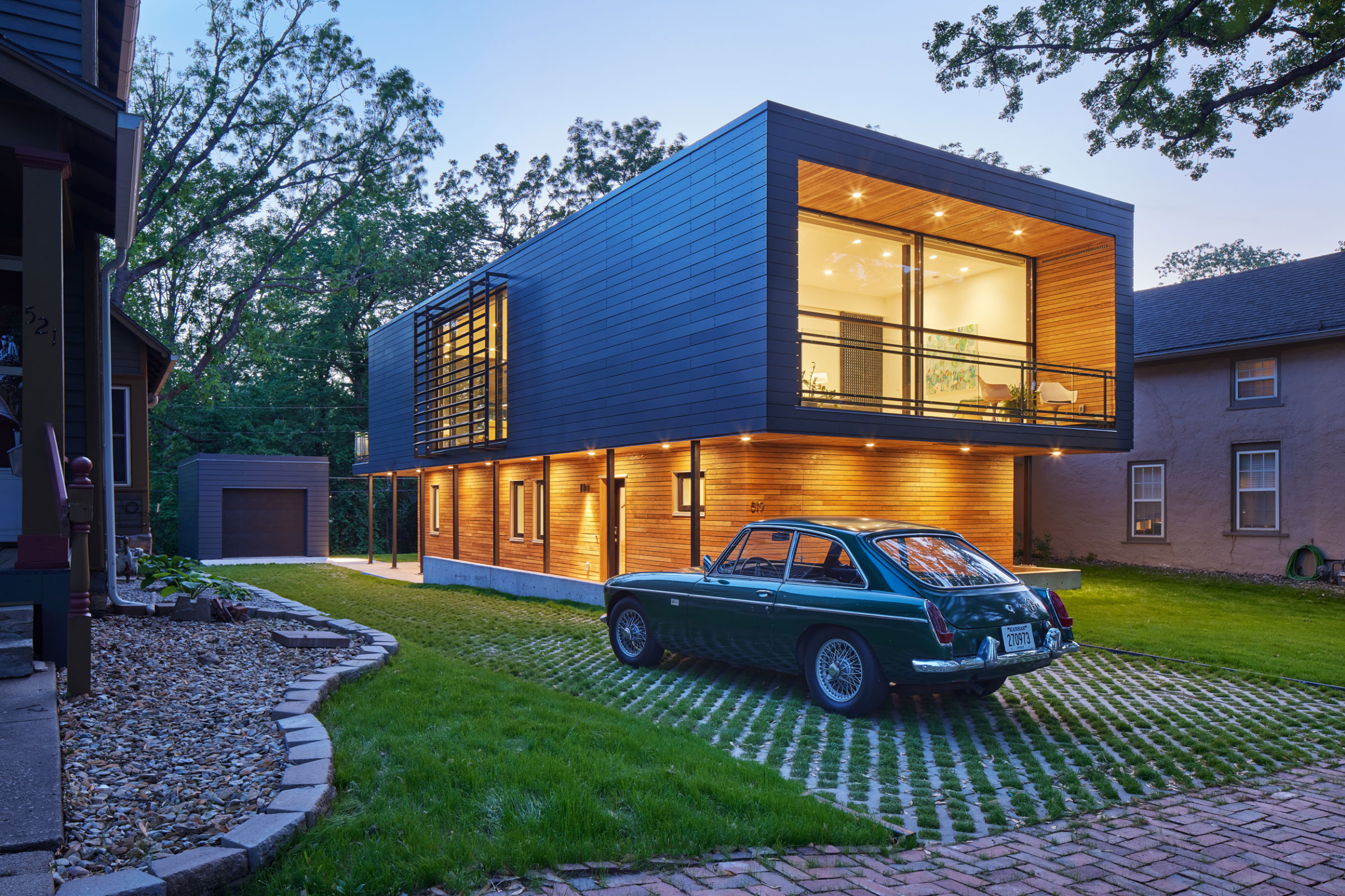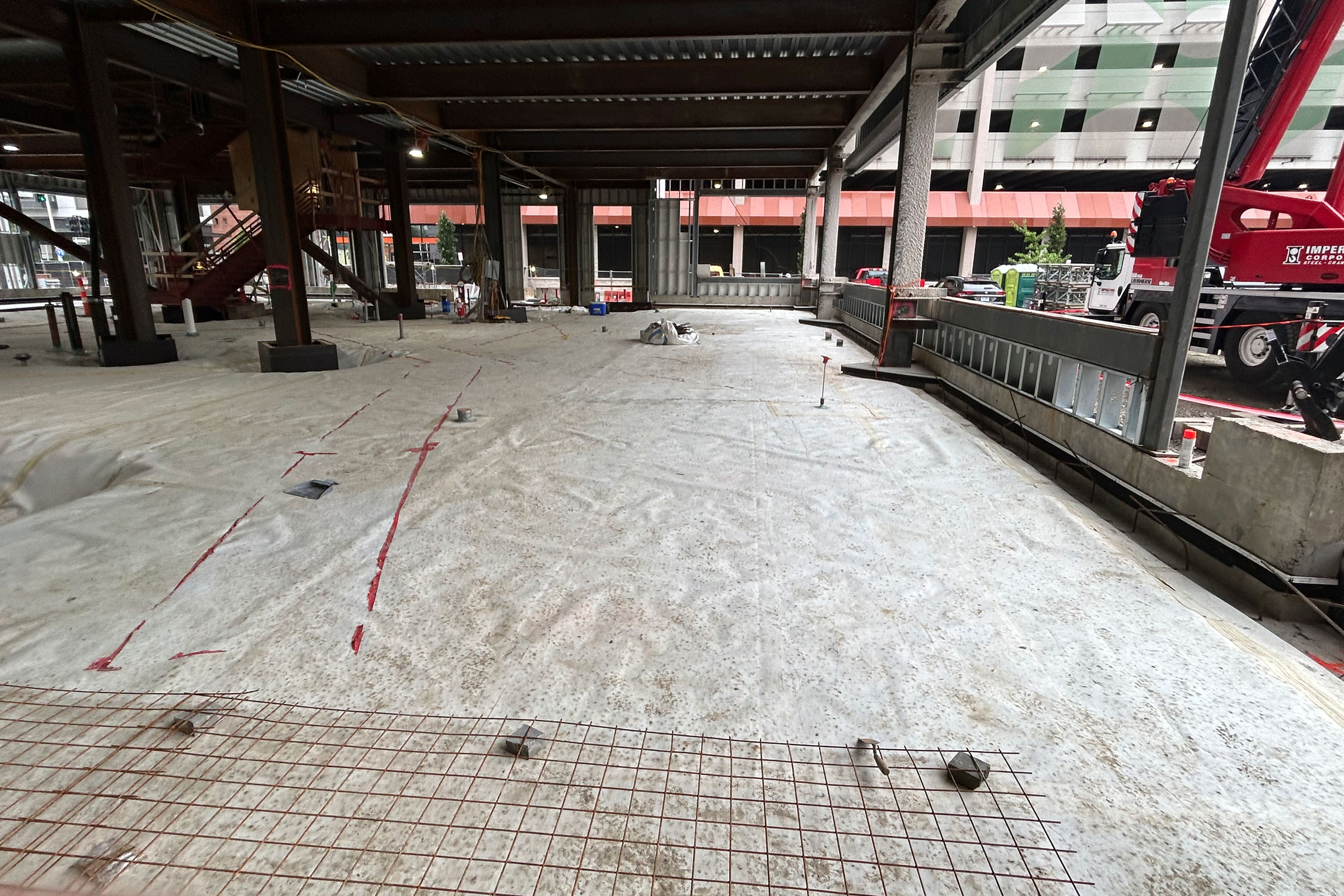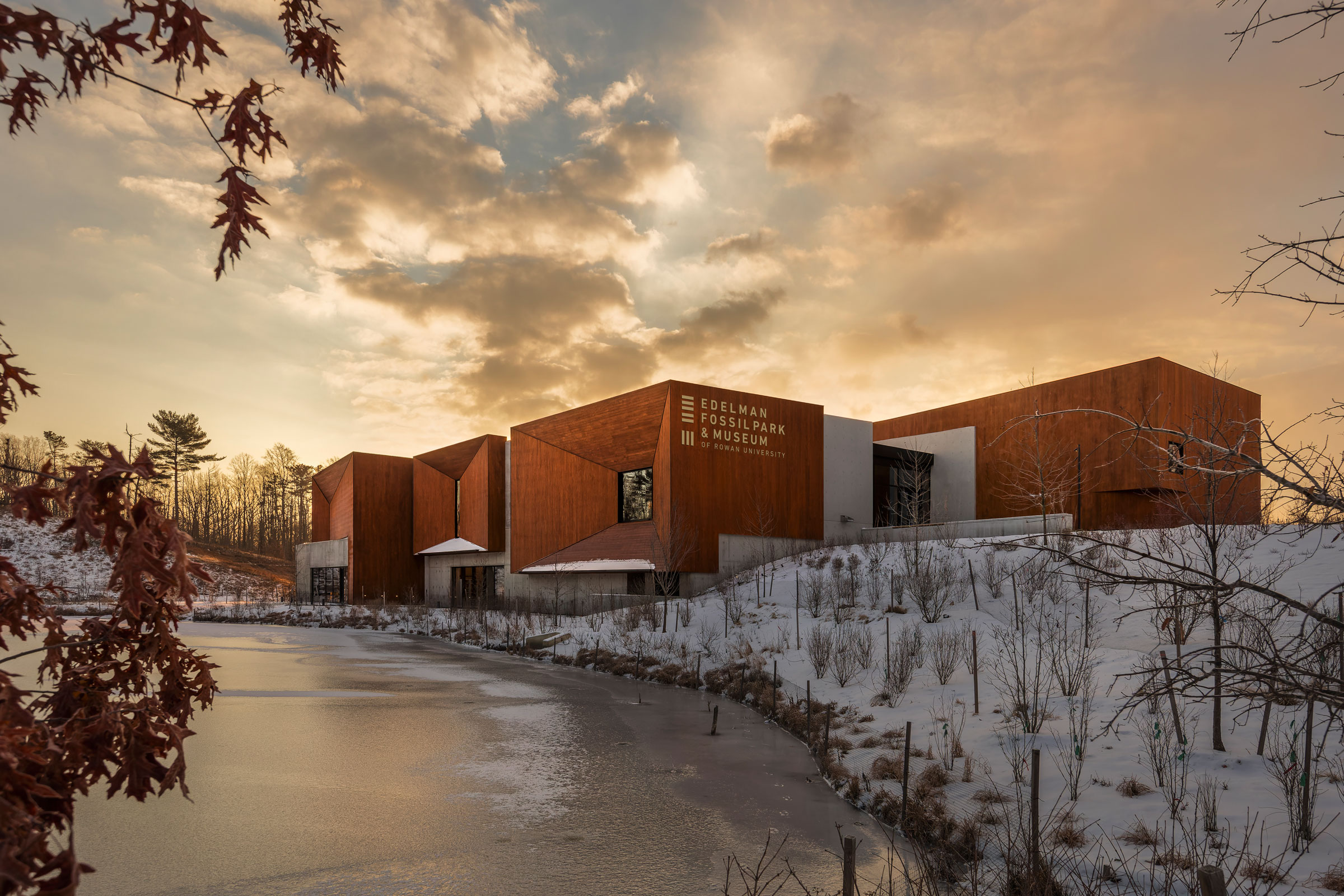Story at a glance:
- Some of the most popular home styles architecturally are bungalows, cape cods, and Victorians.
- Many of today’s popular home architectural styles borrow from forms from the early 1900s.
- We explore the pros and cons of some of today’s sought-after styles.
Modern, farmhouse, industrial, Mediterranean—there’s a seemingly endless list of residential architecture styles to choose from when buying, designing, or building a home. While trends like tiny homes come and go, some of the top home trends are focused on bold colors and organic forms.
These are just some of the most popular home styles in 2025.
The Most Popular Home Styles in 2025
Contemporary
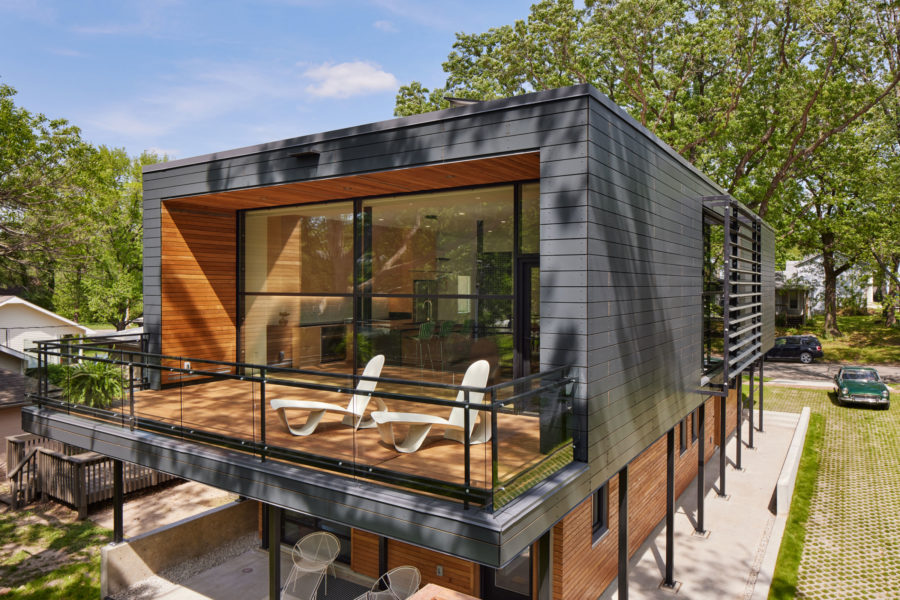
The Indiana Street House was designed by Studio 804 and is an excellent example of contemporary home design. Photo by Gaffer Photography
Often recognizable by their large, tall windows and lack of ornamentation, contemporary style homes often have an unusual mix of materials—like stone, brick, wood, and glass. This mix allows homeowners to reap the benefits of some of the best building materials while still feeling like they live in a traditional house.
What we now consider contemporary-style architecture is largely inspired by the designs of mid-century modern homes built between 1950 and 1970. These homes increasingly make use of flat roof systems, although gabled roof types are also incredibly popular, with the latter often characterized by exposed beams. Both tend to be designed to incorporate the surrounding landscape.
Take the Indiana Street House, for example. Designed by Studio 804, the two-story flat-roofed home is strikingly simple in form, emphasizing straight lines and simple shapes. Large windows also bring ample daylight into the interior. Despite its small lot size, the Indiana Street House is still respectful of the landscape, appearing as though it is emerging from the ground itself thanks to the 11-foot drop in grade from front to back. The driveway also employs a permeable paver system to help improve stormwater management.
Advantages
- Natural light
- Spaciousness
- Often surrounded by nature
- Sustainable building materials
Disadvantages
- Can be bland
- Prone to damage (broken glass, etc.)
- Expensive
- Trendy
Neoclassical
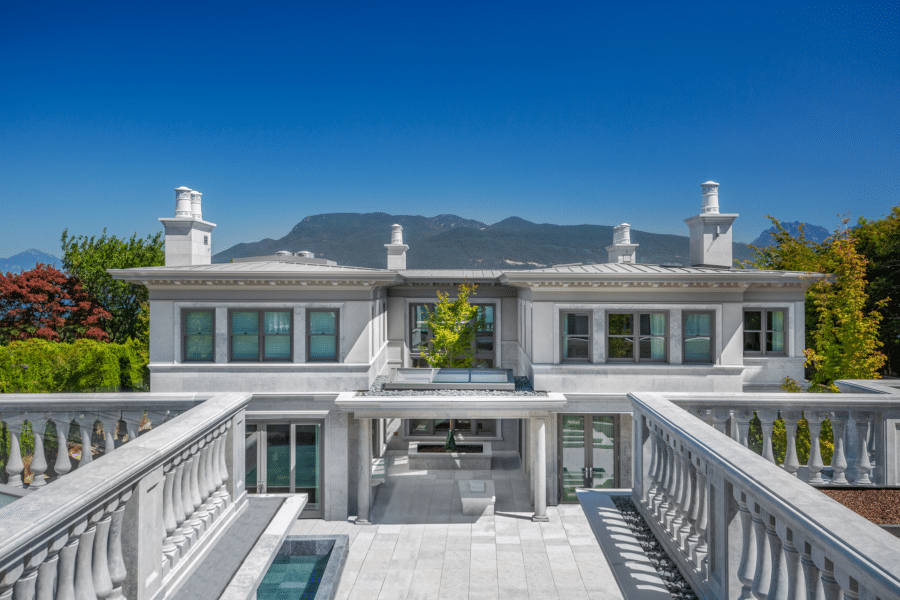
This neoclassical private residence in Vancouver was built with Polycor’s SAINT CLAIR Fleuri Marble from Oklahoma, fabricated and installed by Red Leaf Stone. Photo courtesy of Polycor
Emerging in the late 1800s as a response to the excess of the Rococo style, Neoclassical-style homes take inspiration from the relative simplicity of classical Greek and Roman designs. Homes constructed in the Neoclassical style are typically built from brick and stone and are characterized by grandeur of scale, simple geometries, symmetry of form and fenestration, as well as austere, unadorned exteriors.
Neoclassical houses might be one or two stories tall and often sport a temple front facade featuring dramatic, evenly-spaced Ionic, Doric, or Corinthian columns capped by either a pediment, portico, or dome. The interior of a Neoclassical-style house typically features built-in furniture, large rooms, tile or stone flooring, and decorative designs above and around doorways.
An example of a modern Neoclassical-style home is the Saint Clair Country Estate in Vancouver. Completely clad and ornamented in American limestone, this rural mansion takes inspiration from the relative simplicity of classical Greco-Roman designs and is characterized by grandeur of scale, symmetry of form and fenestration, and refined ornamentation.
All of the stone used in the project was supplied by Polycor and sourced from the company’s Marble City, Oklahoma limestone quarry. The dense grey-beige stone—referred to as Saint Clair—sports a wavy grain pattern and is freeze-thaw resistant, making it an excellent choice for projects in the Pacific Northwest.
Advantages
- Symmetrical design
- Large rooms
- Durable and long-lasting
- Ideal for families
Disadvantages
- Expensive to build or buy
- Can be difficult to clean and maintain
- May appear imposing to some
- Not as conducive to a relaxed or casual lifestyle
Cottage
A cottage is easiest understood as a small home for a single family. Cottage-style architecture is celebrated for its simple design, coziness, and ability to stand the test of time. Cottages can be designed in a number of styles, including English, Nordic, Canadian, American and South African.
Advantages
- Coziness
- Longevity
- Location
- Simple design
- Encourages togetherness
Disadvantages
- Small floorplan
- Maintenance
- Location
- Can feel cramped
- Resale value
Farmhouse
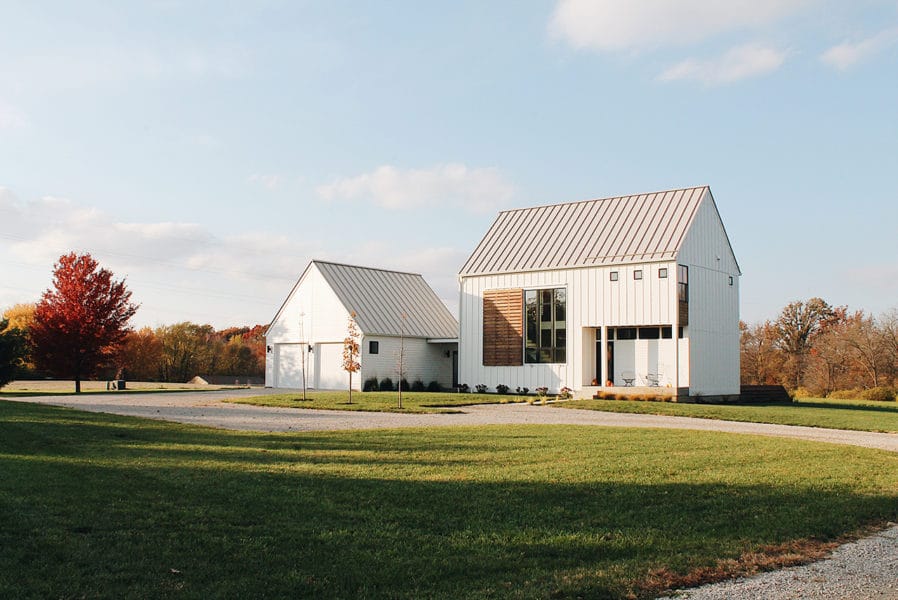
The Nixon Road house in Indiana was built by Cedar Street Builders and designed by David Rausch. Photo by Kelsey Johnston
The modern farmhouse style emphasizes a cozy feel with a modern-yet-rustic look. Among the farmhouse style, farmhouse modular homes are on the rise. Here, elements of warm minimalism also come into play, with farmhouse modular homes embracing simplicity and comfort. Modern farmhouses emphasize function, natural materials, organic color palettes, and a variety of textures, to name a few more characteristics.
The Nixon Road modern farmhouse in Indiana, for example, was designed by David Rausch and built by Cedar Street Builders to be a simple, clean, and energy-efficient residence with all the charm of a traditional farmhouse.
“The architect, David Rausch, did a nice job of keeping the design simple while providing a unique home that is very pleasing to look at and live in,” Cedar Street Builders owner Dan Porzel previously told gb&d. “The house is a simple two-story rectangle, which helps make it cost-effective and energy-friendly. Solar orientation maximized south-facing widows and minimized them on the west. We kept materials to durable basics, while spending a little extra on the durable metal roof and wood accents.”
Advantages
- Flexible design
- Inexpensive
- Low maintenance
- Often in nature
Disadvantages
- Can be isolating
- Difficult to personalize
- Finding fixtures that match the style
- Could look dated
Townhouse
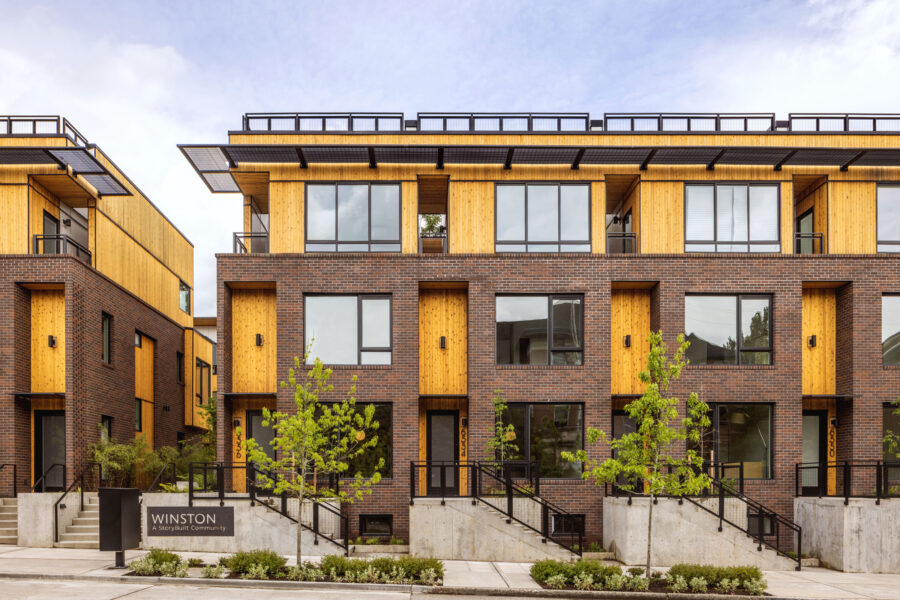
Winston Townhomes was designed by Johnston Architects with careful consideration of materials and the surrounding, single-family neighborhood in Seattle. Photo by Rafael Soldi
In the US a townhouse may refer to two types of housing, separated chiefly by time period. The earliest townhouses, or those dating back to the 18th century, were city dwellings with a very small footprint that spanned multiple floors, often as many as six or more. This iteration of the townhouse was typically owned by a wealthy family, often included servants’ quarters, and allowed the home to be within walking distance of necessary amenities.
These original townhouses were usually constructed from brick and still exist in many dense cities—most notably New York City—to this day, though it’s rare for new ones of this nature to be built.
Modern townhouses—or row houses, as they’re often called—are a bit different in that they can be found not just in cities but almost any urban or suburban area. No longer reserved solely for the wealthy, the contemporary townhouse is an affordable alternative to the detached single-family residence and may be built in a variety of styles, using a variety of materials. They are generally characterized, however, by a continuous roof and foundation with a single wall dividing each adjacent unit from the next.
The Winston Townhomes residential development project in Washington are a contemporary example of this style. Designed by Johnston Architects and developed by StoryBuilt, the Winston Townhomes are comfortably sandwiched between the classic craftsman bungalows of Seattle’s Ravenna neighborhood and strive to compliment the historic character of the surrounding single-family residences.
Advantages
- Affordable
- Low maintenance
- Often close to amenities
- Greater security
Disadvantages
- Minimal outdoor space
- Less privacy
- Reduced square footage
- Typically overseen by a HOA
Ranch
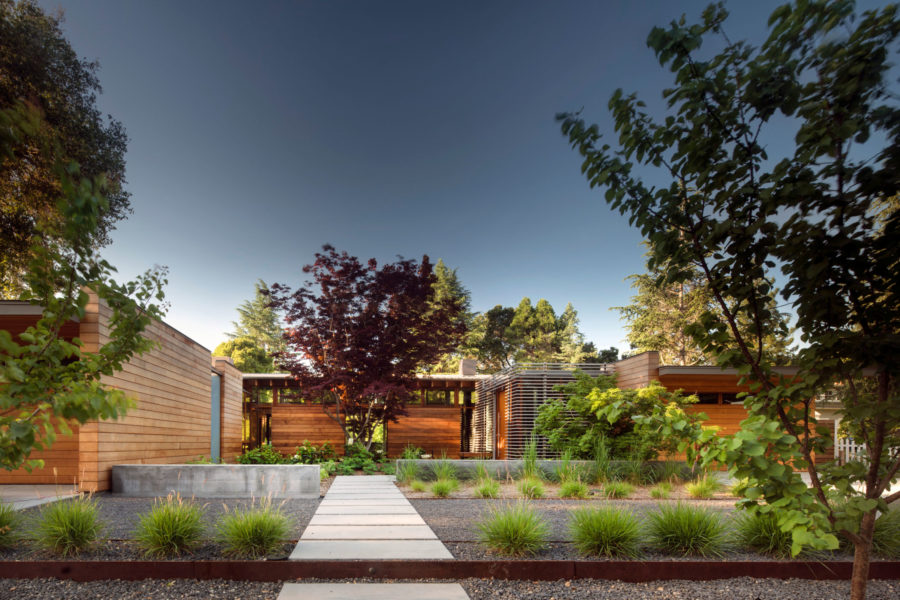
Nestled amongst neighboring houses and a variety of mature trees, Los Altos residence is a modern interpretation of a ranch style home that maintains a sense of privacy and offers its clients, a young family, reprieve from the bustle of daily activities. Photo by Nic Lehoux
The ranch can be traced back to the 1930s in California, where it emerged as one of the most popular American styles in the 1950s and ’60s, according to the NAR. The style harkens back to Spanish Colonial, Prairie, and craftsman homes and is known for its one-story, pitched-roof construction, built-in garage, wood or brick exterior walls, sliding and picture windows, and sliding doors leading to patios. These homes are typically one story.
The BCJ-designed Los Altos residence, for example, is a modern interpretation of the traditional Ranch-style home, heavily emphasizing key elements like timber siding and the blurring of indoor-outdoor spaces.
Advantages
- Low maintenance
- Affordable
- Easy to design
- Easy to evacuate
Disadvantages
- Requires more property
- Limited design flexibility
- Can feel cramped
- Smaller yard
Italianate
Seen frequently in San Francisco, the Midwest, and along the East Coast, Italianate-style homes rose to prominence in the mid-1800s and derived inspiration from traditional Italian architecture. Unlike most styles, Italianate homes are not defined by their form but exclusively by their ornamentation; one might find Italianate-style homes in a variety of shapes and sporting any number of floors, though a square footprint is most common.
Italianate-style homes were usually constructed from brick, stone, and stucco. These homes may be identified by their small, irregularly-set chimneys; towers and belvederes; overhanging eaves supported by decorative brackets; tall, narrow bay windows; elaborate supports, columns, and door frames; cast-iron embellishments; and entryway porticoes.
Advantages
- Excellent curb appeal
- Ideal for large families
- Durable and long-lasting
- High ceilings
Disadvantages
- High maintenance
- Can be expensive to repair
- Not as accessible to those with mobility issues
- Often require more involved landscaping
Cape Cod
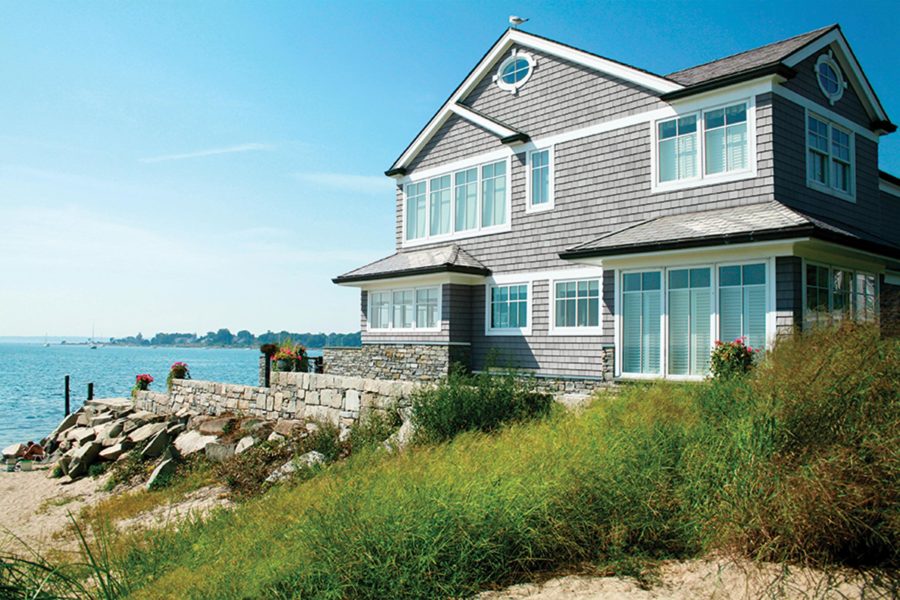
Photo courtesy of Derby Building Products
Cape Cods are some of the earliest houses built in the US—dating back to the 17th century in New England when the first colonial style Cape Cods were shingle-sided, one-story cottages with no dormers.
During the mid-20th century the small, simple style was prevalent in suburban developments. The style evolved into a square or rectangular structure with one- or one-and-a-half stories, accompanied by steeply pitched, gabled roofs. It may have dormers and shutters.
The siding on traditional Cape Cod-style homes is usually clapboard, cedar shake, or brick, though contemporary designs have increasingly begun prioritizing engineered cladding products that look like weathered wood but which are much more resilient to coastal weather. Derby Building Products’ composite Beach House Shake, for example, offers the aesthetic of natural cedar without the risk of moisture damage and decay.
Advantages
- Inexpensive to build
- Flexible design options
- Curb appeal
- Built to last
Disadvantages
- Relatively small floorplan
- Frequently have low ceilings
- Difficult to expand
- Hot second floor
Dutch Colonial
As the name suggests the Dutch Colonial-style house originated with Dutch (Netherlands and German) settlers in the Pennsylvania Colony sometime during the early 1600s. These early iterations typically possessed only a single room, though it gradually became commonplace to add additions on either end of the house, resulting in a very distinct, linear floor plan that persists to this day.
Dutch Colonial-style homes are most commonly identified by their distinct gambrel—or hipped—roofs with sloped, flared eaves, but there are versions which implement non-hipped roofs as well. Most Dutch Colonial-style houses featured stone and brick or clapboard walls set on a stone foundation and were built to either one-and-a-half to two stories high.
Notable characteristics of the Dutch Colonial-style home include double-hung sash windows, an offset double Dutch door, large rooms, and a porch along both of the home’s long sides.
Advantages
- High resale value
- Large square footage
- Simple layout
- Ideal for families
Disadvantages
- Can be inaccessible to those with mobility issues
- Feature distinct rooms rather than an open floor plan
- Can be expensive
- Costly maintenance and repairs
Spanish Colonial

Casa Zero is a prime example of the Spanish Colonial-style home. Photo courtesy of CarbonShack
First appearing in North America during the 1600s with the arrival of Spanish settlers, Spanish Colonial-style homes would remain popular until the mid-1800s before gradually falling out of style—for a time, that is. Influenced by the traditional architecture of Spain, Spanish Colonial-style homes are designed with warm, dry climates in mind and can be found primarily throughout the Southwest, California, and Florida.
Key characteristics of the Spanish Colonial-style home include red clay roof tiles, thick adobe walls covered in white stucco, small windows, wooden support beams (like those found in Pueblo-style homes), arched doorways, extensive use of terra-cotta tiles, wrought iron grillwork, and a central or rear courtyard. Casa Zero, for example, is a home in Los Angeles designed by CarbonShack Design that blends elements of the Spanish Colonial style—namely the red clay tiles and white stucco walls—with characteristics of the Mission and Craftsman styles.
Spanish Colonial-style homes would later go on to influence the Spanish Revival and Spanish Eclectic styles, both of which share many of the same features and characteristics. The Spanish Colonial-style house is also considered the ancestor of our modern Ranch-style house.
Advantages
- Designed for easy cooling
- Rich, aesthetically-pleasing character
- Indoor-outdoor living
- Use of natural, sustainable materials
Disadvantages
- Often susceptible to water damage
- Not suitable for all climates
- Can be high maintenance
- Expensive to build or buy
Greek Revival
Archaeological findings of the early 1800s—combined with growing support for Greece’s 1820s war for independence—reignited an interest in classical Greek architecture amongst the American populace, out of which the Greek Revival-style home was born. These homes quickly grew in popularity and are found in New England, the Midwest, the South, and even parts of California.
Characterized by a return to Classical features and ornamentation, Greek Revival-style homes may be identified by their gabled or hipped roofs, wide-trimmed roof cornices, full-height or full-width porches, dramatic entryway columns, elaborate door surrounds, pilasters, and a front door surrounded by narrow windows.
Inside, a Greek Revival-style home typically featured a simple and relatively open floor plan, wide plank floors, plain and unadorned plaster walls, ornate plasterwork ceilings and ceiling mantels, as well as tall windows and doors.
Advantages
- High curb appeal
- Symmetrical design
- Relatively easy to maintain
- Large, spacious rooms
Disadvantages
- Can be expensive to maintain
- Costly to repair
- May appear imposing
- Difficult to heat and cool
Georgian
Named after England’s four King Georges, the Georgian-style home draws influence from the elaborate home designs of England and rose to popularity in the US during the 18th century.
Traditional Georgian-style homes were typically constructed from brick or stone that was then covered in stucco and are characterized by symmetry—both in form and window placement—paired chimneys, side-gabled roofs, Doric columns, a pediment above the front entryway, and a transom window over a paneled front door.
Inside, Georgian-style homes often feature spacious rooms, high ceilings, and timber paneling, as well as decorative plaster cornicing, ceiling roses, ironwork, and pared-down Romanesque detailing. Rooms might make use of either wooden or tile flooring and typically featured a pastel color scheme or delicately-patterned wallpaper.
Advantages
- High curb appeal
- Symmetrical design
- Ideal for families
- Large, well-proportioned rooms
Disadvantages
- Rarely have front porches
- Higher maintenance costs
- Renovations require specialists
- Expensive to buy or build
Tuscan
Inspired by the traditional architecture of the northern Italian region of Tuscany, Tuscan-style homes share certain elements with both the Italianate and Spanish Colonial styles of home. Tuscan-style homes are characterized by the use of rough-cut stone, terra-cotta barrel tile roofs, stucco and plaster walls, wrought-iron railings and detailing, as well as an irregular footprint with additive forms.
Tuscan home interiors typically feature high, vaulted ceilings, arched doorways, exposed wooden beams, and wood and tile flooring. Most Tuscan-style homes have multiple fireplaces with prominent chimneys and often include a rear or side courtyard.
Advantages
- Rustic charm
- High curb appeal
- Large, sprawling layout
- Ideal for families
Disadvantages
- Can be difficult to heat evenly
- Very expensive to build or buy
- Often require more intensive landscaping
- Maintenance can be costly
Shotgun
It’s said that if you fire a shotgun through the front doorway of a Shotgun-style house, the slug will exit directly out the back door—and while that’s certainly not advisable, it should give you a good idea of the layout of this style of home.
Identifiable by their long, narrow appearance, Shotgun-style homes are usually single-story, rectangular buildings whose rooms are arranged in linear fashion, one behind the other. A typical layout sees the living room first, followed by two bedrooms in succession, and a kitchen at the back. A bathroom might be included before the last room or as a side addition to the kitchen.
Most Shotgun-style houses are capped by a gabled roof that overhangs the front entry to create a full front porch supported by decorative brackets and ornamentation. Rooms in a Shotgun-style house are fairly spacious and typically feature high ceilings, as well as some form of decoration such as elaborate woodwork or molding.
Advantages
- Easy to heat and cool
- Extremely low build cost
- Possess a large front porch
- Ideal for cross ventilation
Disadvantages
- Small and narrow
- Less privacy
- No central hallway
- Little-to-no yard space
Classic Cottage
Popular in New England during the mid-19th century, the Classic Cottage-style home is considered to be an evolution of the traditional Cape Cod-style home.
Classic Cottages keep the one-and-a-half story, eaves-front form characteristic of the Cape Cod, but incorporates certain elements of Greek Revival-style homes, such as flat corner columns, a wide cornice band beneath the eaves, flat entablature and pilasters around the front door (which may or may not be centered), sidelights alongside the door, and six-over-six windows.
Advantages
- Large and spacious
- Ideal for families
- Simple but elegant details
- Energy-efficient
Disadvantages
- Small, almost non-existent front porch
- Can be high maintenance
- Considered boxy and unattractive by some
- Can be expensive to build or buy
Craftsman
First popularized by architect and furniture designer Gustav Stickley in his magazine The Craftsman at the turn of the 20th century, Craftsman-style homes are similar to the conventional bungalow but lack any sort of real ornamentation. Stickley has said the incredible simplicity of the Craftsman home was meant to evoke a natural, almost organic character that allowed the home to blend in with any landscape.
Some of the most common materials used in Craftsman house design include rough-hewn wood, natural stone, and stucco. Identifying exterior features typically include a low-slung gabled roof, overhanging eaves, and very wide front porches, of which were often framed by squat tapered columns on elevated pedestals.
Craftsman-style homes are generally designed around an open floor plan and might include interior elements like exposed roof rafters or beamed ceilings, handcrafted furniture, and dark wooden molding and wainscoting.
Advantages
- Typically have large porches
- Handcrafted aesthetic
- Lower build cost
- Sustainable building materials
Disadvantages
- Some may find them plain
- Low square footage and smaller room size
- Susceptible to termite damage
- Upkeep can be expensive
Mediterranean
Mediterranean style houses are known for their low-pitched red-tiled roofs—often clad in terra-cotta—as well as an exterior that incorporates brick or stucco, often painted white. They often offer sprawling layouts with arched windows and doorways and even wrought-iron balconies and beautiful gardens.
Advantages
- Large floorplan
- High ceilings
- Natural ventilation
- Durable
Disadvantages
- Expensive to maintain
- Not suited for colder climates
- More prone to pests
- Utility bills
Victorian
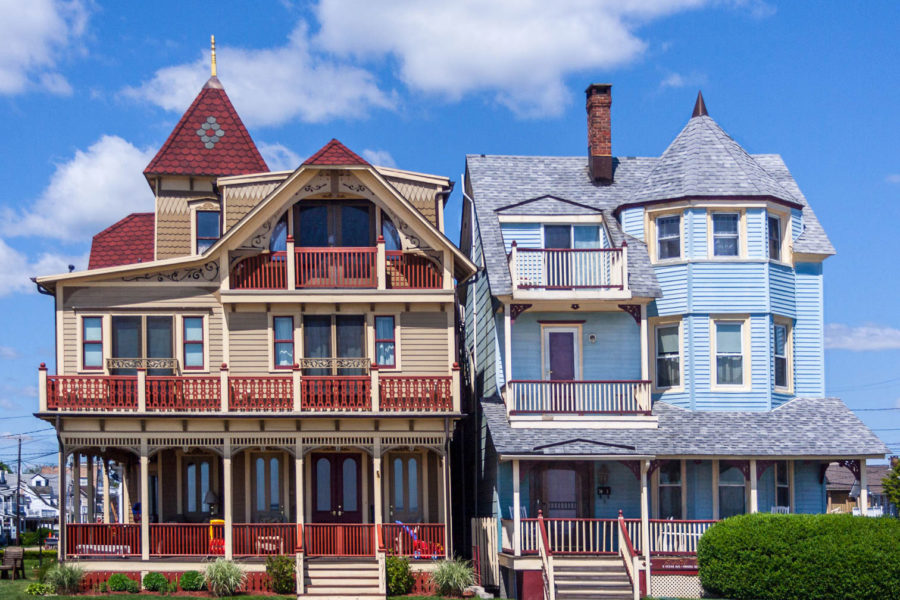
Two Victorian style houses in Ocean Grove, New Jersey. Photo by Paul VanDerWerf, Flickr
You’ll know it’s a Victorian when you see Gothic influences and intricate woodwork. Victorian style houses often have pitched roofs, wraparound front porches, cylindrical turrets, and roof towers. Victorian architecture dates from the second half of the 19th century, when America was exploring new approaches to building and design, the NAR says. The last true Victorians were built in the early 1900s, but contemporary builders often borrow Victorian ideas, combining modern materials with 19th century details like curved towers and spindled porches.
Advantages
- Curb appeal
- Design flexibility
- History
- Many rooms
Disadvantages
- Higher maintenance
- More energy to heat/cool
- Smaller rooms
- Less storage
Bungalow
A bungalow is considered to be a fairly narrow, rectangular one-and-one-half-story house, according to the National Association of Realtors (NAR). The beloved style originated in California in the late 19th century in response to the elaborate decoration of Victorian homes.
Bungalows are known by their low-pitched gabled or hipped roofs and small covered porches at the entry. The style was so popular in the early 1900s that “bungalow kits” were even sold in the Sears and Roebuck catalog. In 1918 some of the most popular house kits, including bungalows, cost roughly $3,600 to $4,600, according to an article from Forbes.
Advantages
- Accessibility
- Affordability
- Open floor plans
- Low maintenance
- Considered a good investment
Disadvantages
- Higher cost per square foot than two-story home
- Limited storage
- Smaller bedrooms
- Some consider outdated
Tudor
When you think of a storybook house, there’s a good chance you imagine a Tudor style home. This architectural style was extremely popular in the 1920s and ’30s but continues to be a favorite in suburbs across the US—and especially the Northeast—according to the NAR.
Originally used to describe the types of houses built during the Tudor era of 17th- and 18th-century England, the Tudor style of architecture is characterized by the use of hand-hewn timber, thick stone-and-brick walls, and steep gable roofs. Half-timbering on bay windows is also common, as are rounded doorways, multi-paned casement windows, and large stone chimneys.
New Tudor-style homes are rarely built today, though there are many renovated Tudor homes for sale throughout the New England region of the United States.
Advantages
- Curb appeal
- Interior design flexibility
- Durable roofing
- Large floorplan
Disadvantages
- Lack of natural light
- Upfront expense
- Higher maintenance
- Heavy architectural proportions
Adam
Adam-style homes—named after the brothers who popularized the design in Britain—are localized almost exclusively along the East Coast and rose to prominence in the late 1700s before falling out of style in the early-to-mid 1800s.
The Adam-style is synonymous with the Federal-style of architecture and is characterized by a reintegration of Greek and Roman elements. Resembling the Georgian style in form, Adam-style homes often possess a square or rectangular footprint, run two rooms deep, and rise two to three stories off the ground. They are usually built from brick, feature an extremely flat facade, and are capped by a side-gabled roof.
Adam-style houses may be distinguished from their Georgian predecessors by their dramatic front door with sidelights and semicircular fan light, a central arched Palladian window, carved white columns, molding, and garlands with delicate detailing.
Advantages
- Highly symmetrical
- Incredibly durable
- Possess a historic charm
- High square footage
Disadvantages
- Can be difficult to modernize
- Repairs and maintenance are likely to be costly
- Multiple levels pose accessibility challenges
- Exterior can appear imposing or lifeless
Barn
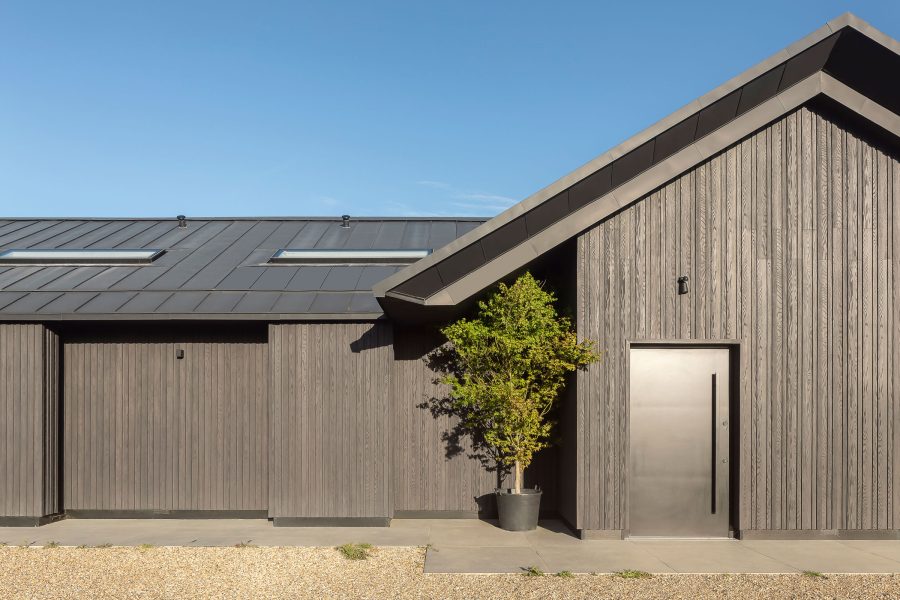
The Weald House was designed by MailenDesign and Peter Bradford Architects to emulate the traditional barns found throughout the English countryside, albeit with a modern twist. Black cladding crafted from oak molded timber composite cladding was a natural choice given the site’s agricultural history. Photo by Peter Landers
Rather than imitate the traditional farmhouse, barn-style homes seek to mimic barns themselves—and as such, may be built in a variety of designs influenced by vernacular architecture. The Weald House in Kent, for example, was designed by MailenDesign and Peter Bradford Architects to emulate the region’s traditional black agricultural barns. “As you come down the lane it’s hard to tell that it’s a domestic house,” Ben Mailen, project director and founder at MailenDesign, previously told gb&d.
In the United States, many barn-style homes make use of a gambrel roof, or a symmetrical two-side roof that features two distinct slopes at different pitches. Hip-roofed and gable-roofed Barn-style homes are also popular.
Regardless of their design, barn-style homes typically make use of either a timber frame or post-and-beam frame, both of which support an open floor plan that allows for a spacious interior. Almost all Barn-style homes are clad in some form of wood plank siding, with the most common being vertical plank, board-and-batten, and shiplap.
Predictably, barn-style houses are characterized by a rustic aesthetic and prominently feature exposed wood, handcrafted furniture, and sliding barn doors in their designs.
Advantages
- Rustic charm
- High ceilings
- Open floor plan
- Use of sustainable materials
Disadvantages
- Susceptible to water damage
- May run into permit or building code issues
- Can be harder to sell
- Require frequent maintenance
Pueblo
Also referred to as Pueblo Revival and Santa Fe, the Pueblo-style of home is heavily influenced by both the traditional architecture of the Pueblo people—who inhabited what is now known as the Southwestern United States—and Spanish Colonial style. Modern Pueblo-style homes originated in the early 20th century and are localized primarily within the Southwestern states, particularly New Mexico and Arizona.
Like the original Pueblo buildings, Pueblo-style homes typically make at least minor use of adobe in their construction, though brick and concrete often make up the majority, if not the entirety, of the structure itself. Walls are then covered in stucco and painted over using desert earth tones. Because they are built from materials with a high thermal mass and are designed for use in hot, dry climates, Pueblo-style homes are incredibly energy-efficient.
Pueblo-style homes are identifiable by their thick, sloping walls, rounded corners, irregular parapets, and flat roofs. Projecting wooden roof beams or vigas—which may or may not serve a structural purpose—and curved corbel beam supports are common characteristics in Pueblo house design.
Advantages
- Energy-efficient in hot, dry climates
- Traditionally built from sustainable materials
- Ideal design for natural ventilation
- Aesthetically-appealing
Disadvantages
- Can be high maintenance
- Vulnerable to water damage
- May not comply with modern building codes
- Require a stronger foundation
Queen Anne
Emerging in the United States during the late-Victorian and early-Edwardian periods (1880 – 1910), the Queen Anne-style of home is not as strictly defined as some other styles and covers a wide range of distinct architectural elements.
Typically sporting an asymmetrical facade that utilizes different wall textures, Queen Anne-style houses often feature a prominent front-facing gable, overhanging eaves, pyramidal/hipped slate or wooden roofs, oriel and bay windows, bands of leaded windows, classical columns, elaborate trim, latticework, and pedimented porches. Traditional Queen Anne-style homes span at least two floors (or at least a finished attic) and may incorporate round, square, or polygonal towers as well as second-story balconies or porches.
Wainscoting, window surrounds, door surrounds, and other detailing can be found throughout the interior and rooms are usually asymmetrical in design—as such, Queen Anne-style homes generally lack a central hallway.
Of all the characteristics of the Queen Anne-style, however, the wrap-around, L-shaped front porch is perhaps the most significant and remained a staple even in the simplified Queen Anne cottages and unadorned Shingle style-homes—offshoots of the Queen Anne-style that became popular in rural areas during the early 1900s.
Advantages
- Charming and unique
- Extremely photogenic
- Large wrap-around front porch
- Potential tax incentives/benefits for restoration
Disadvantages
- Can be difficult to heat and cool
- Often costly to build or restore
- Lack a central hallway
- May be difficult to find a suitable contractor
Split-Level
As the name suggests, Split-level homes are a style of house characterized by split or staggered floor levels. Emerging in the years following World War II, split-level style homes became increasingly commonplace with the proliferation and expansion of post-war suburbs and remain a popular housing style to this day.
There are five widely recognized variations of the split-level home, including:
- Side-split. The most popular type of split-level home in which all three levels are staggered and visible from the front elevation; bedrooms are typically housed above the garage while the main living area is positioned off to the side part-way above and part-way below the bedroom level and garage level, respectively.
- Backsplit. Appears as a single-story home from the front elevation and a two-story home from the back; ideal for building on an incline.
- Split-entry. Consists of a one-level improvement with a basement and two short sets of stairs; the entry is considered to be “between” the floors and the basement is often only partially constructed below-grade.
- Stacked split. Typically features five to six floors instead of three or four, with the additional floors (usually bedrooms) stacked on top of the secondary living area; contains four to five sets of stairs.
- Bi-level. The front door in a bi-level home opens to a landing with a set of stairs leading up and a set leading down; the lower floor is often partially below ground but may also be at-grade, in which case an outdoor staircase is needed to reach the front door.
Regardless of how the home is split, a typical split-level house appears as a lowered Colonial on one side and a Ranch on the other side. All contain at least two sets of short stairs and typically span either three (tri-level) or four (quad) distinct levels.
Advantages
- Affordable
- Ideal for families
- High square footage
- Distinct living spaces
Disadvantages
- Inaccessible for those with restricted mobility
- Sometimes considered unattractive
- Can be difficult to sell
- Harder to remodel
Neo-Eclectic
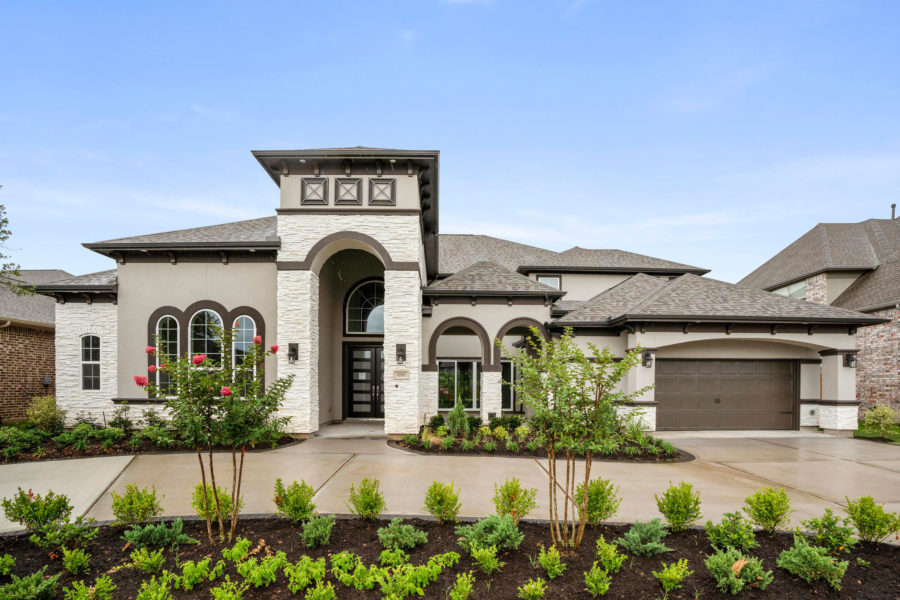
A Neo-Eclectic home featuring Winterhaven Pro-Fit Alpine Ledgestone veneer from CulturedStone. Photo courtesy of Westlake Royal Building Products
Considered an outgrowth of postmodern architecture, the Neo-Eclectic house style can be best described as an amalgamation of different architectural elements found in a variety of revival-type home styles. Many neo-eclectic homes combine design elements from multiple architectural styles in the same building.
Architects in different regions often draw upon various styles when designing these homes, with the Mediterranean Revival and Spanish Colonial Revival styles being incredibly influential on the West Coast and the Georgian Revival, Colonial Revival, Tudor Revival, and Cape Cod styles greatly influencing the design of Neo-Eclectic homes along the East Coast.
Regardless of region, the stylistic elements of Neo-Eclectic homes are almost always superficial, existing only for decorative purposes. Surface-level claddings like architectural stone veneer—such as that manufactured by Cultured Stone, a Westlake Royal brand—are often used in place of their structural counterparts and many Neo-Eclectic homes take advantage of external insulation and finish systems, which may be shaped, textured, and colored to mimic a variety of materials.
Advantages
- Large and spacious
- Ideal for families
- Built-in garages
- Have a modern feel
Disadvantages
- Considered unoriginal and pretentious
- Often make use of cheaper materials
- Require frequent maintenance and repairs
- Harder to heat and cool efficiently
Colonial
The NAR considers the Colonial style as including any house that is rectangular and symmetrical with bedrooms on the second floor. The double-hung windows usually have many small, equally sized square panes. From the late 1800s throughout the 20th century builders made Colonial Revival homes with elegant central hallways and elaborate cornices, according to the NAR. Unlike the original Colonials, Colonial Revival homes are often sided in white clapboard and trimmed with black or green shutters.
Advantages
- Curb appeal
- Privacy (distinct rooms)
- Large floorplan
- Grand front entrance
Disadvantages
- Mobility
- Isolated rooms
- Standard ceiling heights
- Limited light fixture options
Industrial
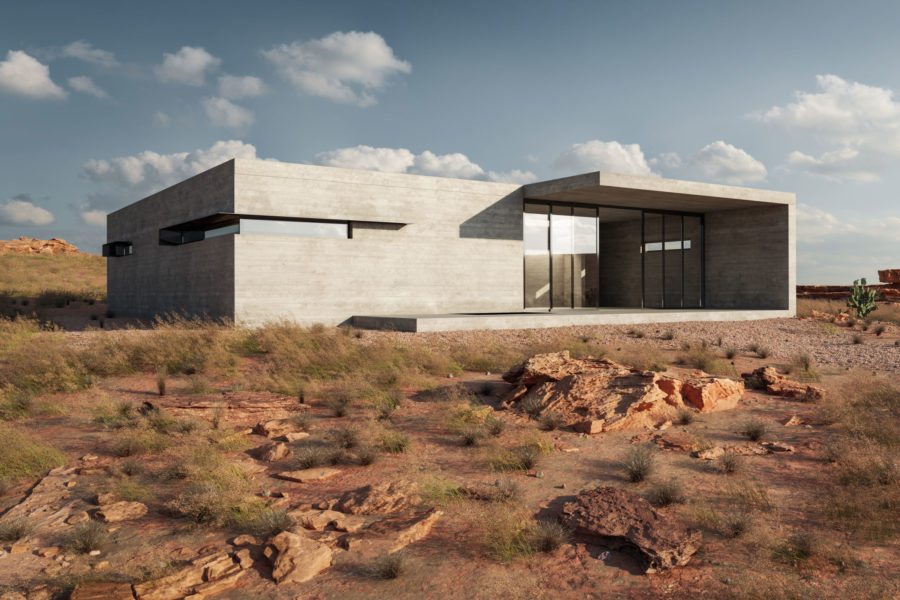
Sharp House was designed to be as economical as possible in construction, with exposed cast-in-place concrete and large glass exposures to the north and south to allow for solar gain and cross ventilation. Photo courtesy of Marc Thorpe Design
An industrial style house typically refers to a home with a simple, unadorned aesthetic that emphasizes materials like concrete or exposed ductwork. Such homes often share certain design characteristics with Brutalist-style buildings and may be recognized by their simple lines, geometric shapes, and liberal usage of exposed raw materials.
The industrial style has become increasingly popular in the US in recent decades, converging with the rise of minimalism and a preference for subdued, neutral color palettes. The industrial-style Sharp House, for example, was designed by architect Marc Thorpe to be as economical as possible, favoring simple geometries and durable materials like concrete—something the clients insisted upon.
“The design could easily be translated into wood or the like, but they wanted concrete. I personally thought concrete would be a nice material because of its tactility. And it’s an honest material, to communicate exactly what the building is,” Thorpe previously told gb&d.
Industrial interior design often mirrors the exterior in terms of a minimalist aesthetic—a characteristic that may appear cold to some, but which can actually be quite cozy when paired with rich textures and the warm whites and woods often seen in Scandinavian architecture.
Advantages
- Simple, raw materials
- Open space
- Flexible design
- Cost
Disadvantages
- Noise control
- Aesthetics
- Skilled labor
- Upfront cost
Most Popular Home Styles of Last Five Years
While each of the aforementioned home styles have been popular at one point or another, very few have enjoyed an enduring popularity that exists to this day—architectural styles come and go, after all.
That said, there are four house styles have repeatedly dominated the US housing market over the last five years, according to data gathered by American Home Shield: ranch, neo-eclectic/traditional, Colonial, and contemporary.
These styles, especially the ranch, have remained popular in large part thanks to their affordability and overall practicality, qualities that make them ideal for families.
Laura Rote contributed to this article.

